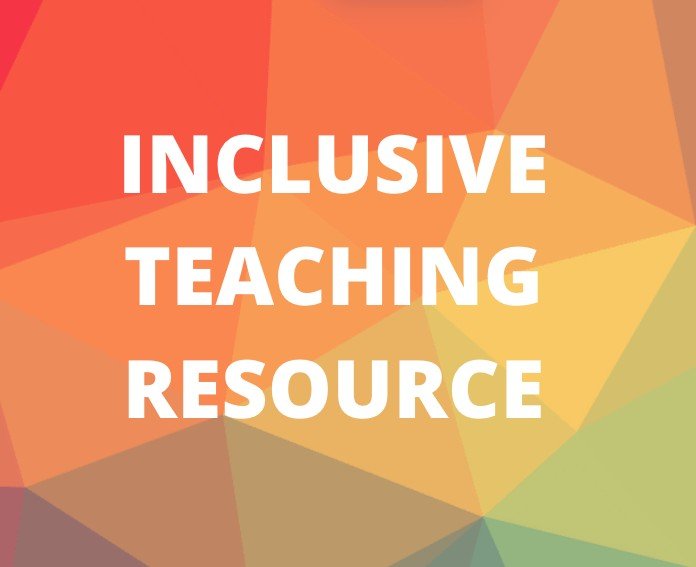Culture of the Classroom
Culture of the Classroom
Culture of the Community
The "Culture of the Community" section features strategies meant to support a diverse and flourishing classroom community, intentionally structured to support well being and belonging for all students.
You might browse the content below, or use the following table of contents to navigate to a particular suggested practice.
- Contextual Awareness
- Implicit Assumptions
- The Emotional Domain
- Solicit Feedback
- Engage Across Differences
- Developing Intrinsic Motivation
- Conflict Resolution
- Acknowledge Traumatic Experiences and Circumstances
- Seeing Students’ Complexity
- Honoring Physical Needs
- Design Inclusive Physical and Digital Environments
Contextual Awareness
Practice and encourage reflection on social contexts and legacies, especially when they have frequently been overlooked in higher education.
Explanation and/or Examples
Discuss with students the value of different kinds of knowledge, including indigenous knowledge and oral traditions, which historically have been overlooked and undervalued in academic contexts. Discuss ways to acknowledge and to cite indigenous knowledge in and beyond academic work.
Acknowledge the land upon which you will teach and learn together through a land acknowledgement or other activity that recognizes the materiality and history of the place of the university.
Resources
Territory Acknowledgement, Allison Jones, Native Land Digital (Website)
Rowan Land Acknowledgement, Rowan University (Website)
Notes for Inclusive Syllabi: Diversity and Land Acknowledgement Statements: Guides & Tips (Boston University, Teaching Writing)
Native American Studies Research Guide (Campbell Library, Rowan University). Includes a page of Research and Writing Resources.
Implicit Assumptions
Investigate your own implicit assumptions in order to identify ways to foster a more inclusive culture.
Explanation and/or Examples
In conversation, choose words and phrasing that are intended to be inclusive of all individuals, in an effort to avoid assumptions about others’ identities and life circumstances. For example:
- Use a variety of gendered and non-gendered pronouns.
- Reference to same-sex partners
- Acknowledge of a range of family and living situations rather than presuming life in a traditional nuclear family
Avoid the assumption of Whiteness as the default or neutral experience.
Consider the historical origins and meanings of words, and avoid using words that may have negative connotations about specific social groups (e.g., being gypped, it went South).
Avoids assumptions or generalizations about students’ family structure, social identities, financial circumstances, citizenship status, or physical ability.
Resources
The Emotional Domain
Demonstrate care for the mental and emotional wellbeing of your students.
Explanation and/or Examples
Acknowledge outside stressors and communicate your wishes for students’ wellbeing.
Build social spaces within the classroom. Invite students to introduce themselves or respond to questions about non-academic topics. This could be via discussion board or icebreakers at the start of class.
Use music, images, or humor to engage students at the beginning of class.
Build in movement and other brain breaks during long or particularly intense class sessions.
Offer a short meditation at the beginning of class to help students become centered, present, and ready to learn.
Learn students’ names and use them.
Resources
A Guide to Incorporating Social-Emotional Learning in the College Classroom: Busting Anxiety, Boosting Ability, Kristel M. Gallagher, Ph.D. Shevaun L. Stocker, Ph.D, Society for the Teaching of Psychology (PDF)
Solicit Feedback
Check in with students regarding their learning and their wellbeing.
Explanation and/or Examples
Invite students to share about their emotional state with a short activity. For example, students might hold up a color card (green, yellow, red) to indicate their mental/emotional readiness to participate in class discussions that day.
Use Google Forms or another platform to ask students what they gained from the day’s lesson, what material they could use more support with, or what questions they have about an upcoming test or assignment.
Place students into small groups at the end of class and rotate through a list of questions to chat about before leaving (here’s an example, also listed in the resources for this practice).
Solicit student feedback on what has been helpful or frustrating about the class using an anonymous survey mid-semester. Or use the Faculty Center’s Mid Semester Focus.
Resources
Mid-Semester Focus, Rowan Faculty Center for Excellence in Teaching and Learning (Website)
21 Quick Questions to Check In on Your Students’ Well-Being in 2023-24, Panorama Education (Web article)
Engage across Differences
Build opportunities for students to respectfully engage you and each other across differences, even outside their comfort zone.
Explanation and/or Examples
Invite students to complete an asset map before collaborative work to learn about the unique strengths each person brings to the group (see Kaitlin Mallouk’s slides from the Spring 2022 RTC GIFTS Conference, also listed in this practice’s resources).
Incorporate the option for affinity groups For example:
- Allow women to self-select into a group together in a predominantly male space.
- Allow students of color to work together in a predominantly white space.
Generate diverse groups based on your own observations of students’ seating and social patterns (choosing one student per quadrant of the classroom to mix into a new group). Avoid stranding one student with a marginalized identity among a dominant identity group.
Resources
Asset Mapping for Equitable Team Work, Kaitlin Mallouk, Spring 2022 Rowan Teaching Connection GIFTS Conference (slides)
Developing Intrinsic Motivation
Help students learn to articulate and celebrate their own learning goals, successes, and challenges as part of a community of learners.
Explanation and/or Examples
Consider the 30-second shout out, in which each student celebrates their own success or another’s.
Have students set their own learning goals, including through SMART charts, perhaps establish peer mentors as accountability partners.
Teach students how to cultivate growth mindset to frame all challenges as an opportunity to learn. Frame feedback on assignments through a growth mindset lens.
Model this in your own learning goals, curiosity and humility. Share your own failures and challenges.
Acknowledge that all people are on their own unique and lifelong learning paths.
Resources
Developing a Growth Mindset with Carol Dweck, Carol Dweck (Video)
Goal Setting Practices that Support a Learning Culture, Kappan (Web article)
25 Best SMART Goals for Students, Brandon Gaille Small Business & Marketing Advice (Webpage)
Three Mindset Shifts that Can Help Students Succeed, Greater Good Magazine, UC Berkeley (Web article)
Conflict Resolution
Plan to address inter-student conflict and respond to microaggressions in the classroom.
Explanation and/or Examples
Co-construct course norms and norms for in-class conversations that can serve as a touchstone in difficult moments.
Educate yourself on microaggressions, how to identify them, and how to address them.
Resources
“OGI Community Agreements” NYU (List)
“Microaggressions in the Classroom” Dr. Yoland Flores Niemann (Video)
“Microaggressions in the Classroom” Portman, Bui, Ogaz, Trevino (PDF)
“Addressing microaggressions in the classroom” University of Washington (Website)
Acknowledge Traumatic Experiences and Circumstances
Acknowledge and respond to current events and traumatic circumstances, allowing space to process within the classroom as appropriate.
Explanation and/or Examples
Different instructors will have varying levels of comfort with responding to traumatic events or experiences. Responses will also depend on the learning context. Even if a class does not discuss an event in detail, acknowledging a challenging situation and reminding students of campus resources for well-being and mental health can promote a supportive environment and sense of community. A variety of possible responses are presented in the examples below.
Offer additional flexibility in the wake of disturbing events on campus or beyond.
Invite students to create a journaling document, blog, or bring in a dedicated notebook for processing their feelings about challenging topics in the news cycle, and welcome them to take them out for the first five minutes of class.
Invite students to share their feelings regarding current events (e.g., the Ukrainian War, Covid-19, Black Lives Matter). Consider a “Head, Heart, and Conscience” reflection, in which they share what they know about a current event, how they’re feeling about it, and what issues of justice it raises for them.
Resources
Current Events in Your Classroom, Facing History (Instruction resources)
Leveraging the Neuroscience of Now, Mays Imad, Inside Higher Ed (Article)
Hand, Heart, Conscience, Facing History & Ourselves (Webpage)
Seeing Students' Complexity
Acknowledge and include students’ different identities and experiences in your course structure and interactions.
Explanation and/or Examples
Distribute a survey before the course begins asking what name and pronouns a student would like to use in class. This can also be used to share other personal concerns: accommodations, conflicts, and general concerns.
Explicitly acknowledge your own identities and biases and how they might play in the classroom. Take an implicit association test to help identify and better understand these biases. (The Harvard Implicit Association Test was designed to measure the strength of implicit associations between concepts. It does not characterize the implicit association, such as positive or negative.)
Normalize neurodiversity through explicit acknowledgement of different learning preferences and strengths in interacting with and responding to course content.
When receiving an accommodation notice for a student from the Office of Accessibility Services, respond with an email to the student indicating receipt and letting them know they can reach out to you if they are struggling with anything in the course. Reach out to the student periodically to ask how they are doing and if there is anything you can do to support their learning needs.
Share your personal pronouns if you are comfortable doing so. Invite students to share their personal pronouns if they would like, while also making clear that this is optional.
Resources
Creating a Positive Classroom Climate for Diversity, Juan C. Garibay, UCLA Diversity & Faculty Development (PDF)
“Implicit Association Test”, Harvard University (Quiz)
A Primer on Pronouns, ASEE (PDF)
Honoring Physical Needs
Recognize and provide students with an opportunity to inform you about barriers they may be facing in meeting their basic needs.
Explanation and/or Examples
Bring granola bars or other kinds of food items to class that students can freely take as needed. Departments can request funds for snacks from Rowan’s Affordability Task Force.
Students are provided with opportunities to make request accommodations for even undocumented disabilities or needs. For example
- a student with visual impairment may need to sit closer to the board
- a student with Crohn's Disease may require more frequent access to the restroom
- a student whose child’s school day begins close to class time may require extra time to park and arrive at class
Resources
Create an Affordability Minded Class!, Rowan University Affordability Task Force (Web page)
Design Inclusive Physical and Digital Environments
Adapt the physical and/or digital environments to meet the needs of diverse students.
Explanation and/or Examples
Consider what sensory inputs students may experience and be affected by. Neurodivergent students have different needs when it comes to the sensory experience of classrooms. For some, sounds during moments of cognitive focus can be distracting, while for others silence can be anxiety-producing or lead to a lack of concentration.
Allow students to identify their needs ahead of time and plan to either work in the classroom or in the hallway according to their assessment.
Resources
“Online Literacy Instruction Principles and Tenets,” Global Society of Online Literacy Educators (Web)
“A Guide to Developing an Accessible Course” Developed by Juliana Rausch, Kristine Lafferty, Leslie Allison, Jade Jones, Celeste Del Russo, and Amy Woodworth in Rowan’s Writing Arts Department (Google Doc, must login with Rowan credentials)
“Inclusive Teaching and Learning Online,” Columbia University for Teaching and Learning

Inclusive Teaching Resource Home
Return to the Inclusive Teaching Resource homepage.

Instructional Content
From assigning diverse readings to making space for student choice, the Instructional Content section supports building courses to serve students' diverse identities and interests.

Teaching Practices
Visit the Teaching Practices section of the resource to learn about suggested pedagogical strategies for inclusive teaching.

Policy
Visit the Policy section to learn more about designing inclusive and equitable classroom policies.

Assessment
Visit the Assessment section to learn about grading contracts, instructional alignment, and more recommendations for equitable grading and assessment practices.

Resources
Visit our curated list of resources to support inclusive teaching practices.
